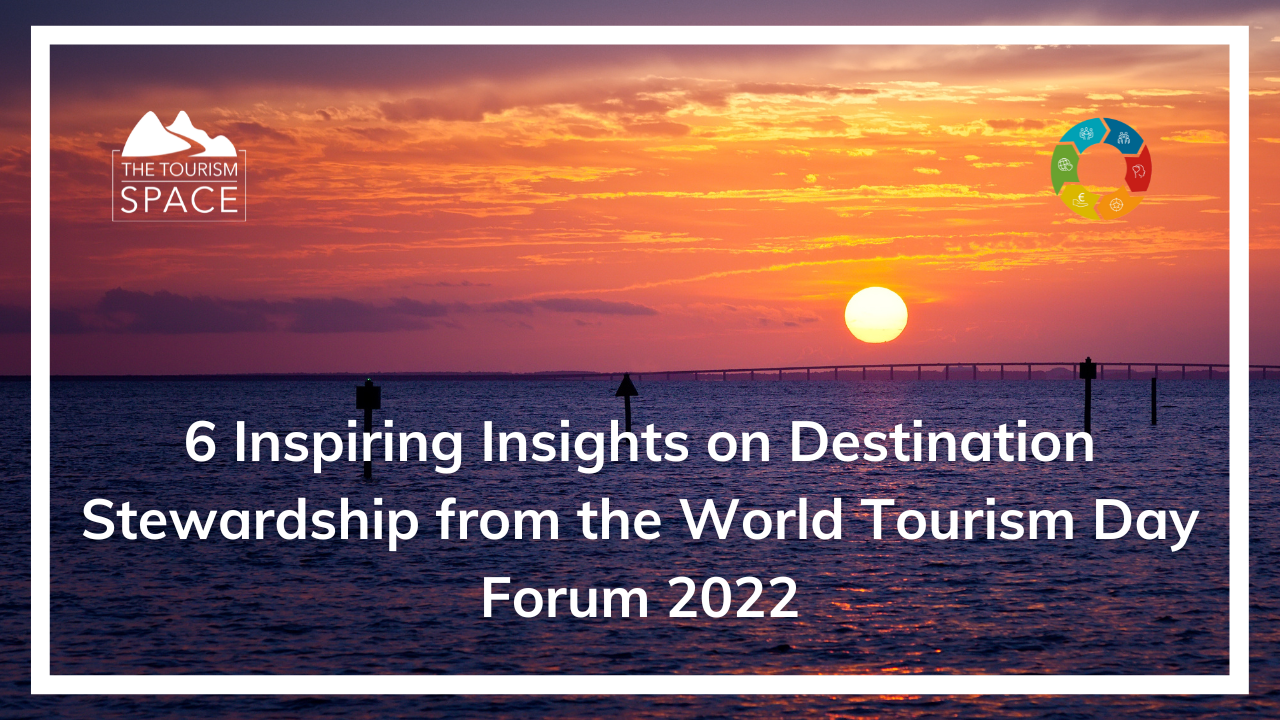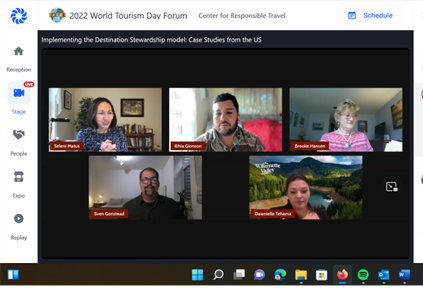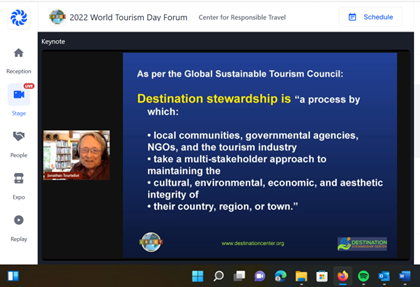
6 Inspiring Insights on Destination Stewardship from the World Tourism Day Forum 2022
Finding Inspiration in the stories of others
“Rethinking Tourism” is the theme for the UNWTO World Tourism Day 2022, celebrated every year on 27th September. It feels like that has been a theme across the tourism industry for about 4 years now – cropping up in slightly different wording in policy documents, conferences and events all over the place.
I’m not a cynical person but as the social media messages around #WTD2022 and #RethinkingTourism, I found myself feeling jaded at the thought of more talking about rethinking tourism. For all the talk – and I know I’ve contributed to it myself – I often find it hard to notice any real change as we move further away from the Covid-19 lockdowns.
Nonetheless, I opted to join the Center for Responsible Travel’s World Tourism Day Forum 2022 yesterday evening. I particularly wanted to hear the talks and discussion on Destination Stewardship. I was so glad that I did. I was reminded again that the more we share of is being done in individual destinations around the world, the more inspiration we can create for the future of tourism.
A focus on Implementing Destination Stewardship Models
This segment included two very short and concise keynotes from Jonathan Tourtellot, CEO of the Destination Stewardship Center, and Lebawit Lily Girma, Editor-at-Large with Skift. Jonathan spoke about the importance of the destination stewardship model and how to combine tourism, stewardship and sense of place into a sustainable strategy. Lebawit spoke about the importance of community-centered storytelling in tourism and the role marketing can and should play in the destination stewardship process.
Their talks book-ended a great panel conversation centering on 4 current case studies from the United States on Implementing the Destination Stewardship Model. The panel included:
- Brooke Hansen, Director Sustainable Tourism, University of South Florida
- Ilihia Glonson, Public Affairs Officer, Hawaii Tourism Authority
- Dawnielle Tehama, Executive Director, Willamette Valley Visitors Association
- Sven Godstead, Chairman, Big Bay Stewardship Council
- Seleni Matus, Executive Director, International Institute of Tourism Studies (Moderator)

So what is Destination Stewardship?
The Global Sustainable Tourism Council define ‘Destination Stewardship’ as
“A process by which local communities, governmental agencies, NGOS and the tourism industry take a multi-stakeholder approach to maintaining the cultural, environmental, economic and aesthetic integrity of their country, region, or town.” https://www.gstcouncil.org/about/gstc-impact/

Here is what the Center for Responsible Travel said about their reason for holding a space for this particular conversation on World Tourism Day:
“It isn’t uncommon for tourism policies and plans to be made without community input, but tourism does not exist in a vacuum. Communities feel the consequences of being excluded: from overtourism and climate and biodiversity threats, to cultural heritage loss and widening social inequities. In order to build a more sustainable and responsible future for tourism – for destination communities, businesses, and tourists alike – we need a more holistic approach, one that puts communities at the center of tourism planning and decision-making. Without doing so we risk losing what makes so many destinations unique and worth visiting.”
6 Inspiring Insights on Destination Stewardship
The discussion was rich and similar themes surfaced in the contributions. Destination Management Organisations (DMOs) that were once charged mainly with marketing may be challenged to transition to a Destination Stewardship approach. With that in mind, here are 6 insights that I took from the discussions as a whole and I thank sincerely each of the contributors for taking the time to share from their experiences.
-
Localise your Model
Brooke highlighted how she loved the model of destination stewardship in Hawaii and took a lot of inspiration from it for Florida. However, she also realised that the same model would not work in Florida. Ilihia concurred, highlighting that within the Hawaiian Islands, what works in one valley may not necessarily work in another. Destination Stewardship models must be localised. It’s granular work and destination stewards must work with local communities to figure it out. While there are overarching guidelines, set out knowing that a customised strategy is needed.
-
Find the Shared Purpose
Dawnielle shared that a key challenge of a Destination Stewardship approach is to find the commonalities between all stakeholders. While a wide variety of stakeholders both inside and outside tourism need to be involved, they are inevitably caught within their own individual silos of activity. Set out to establish that sweet spot, what I like to refer to as ‘The Point of Common Purpose’, that all stakeholders can align with. Once you have that, then responsibility can be shared between different stakeholders. (Having worked a lot on stakeholder engagement, that point of common purpose is almost always around care for place and duty to place.) Sven added to this saying that the stakeholder group must be truly diverse and that roles must be clearly defined.
-
Set tangible, achievable, short-term goals
While a Destination Stewardship approach is based on a long-term view of the world, Dawnielle stressed the need to work hard to create meaningful, shorter-term goals that people can get behind right now, that people can work together on right now. Goals that are far in the future work less well than goals that we can see ourselves responsible for right now. Dawnielle advised identifying the thread that connects work now with work in the future, but focus stakeholders on getting work down right now.
-
Refine your Invitation
Ilihia shared a concept from within Hawaiian culture around the social norms of asking for entry and being granted entry. Related to tourism, I understood the point to be that it’s not for visitors to take entry to a destination for granted and that it’s not for hosts to be flippant about their invitation. Inspired by this concept from within its own culture, the marketing of Hawaii as a destination focuses on refining that invitation that Hawaii makes to guests, thinking hard about how to make that invitation and to whom it should be made. Recognising that all destinations have a maximum capacity, Ilihia concluded by saying destinations or individual tourism hotspots need not to be afraid to communicate ‘We are sorry we can’t invite you at this time. We are hosting others right now so it will be a little while before you can come’.
-
Abandon the ‘Tourist Is King’ Mindset
This insight was shared by Lebawit in her presentation on Destination Marketing within a Destination Stewardship mindset. She highlighted that re-imagining tourism required re-imagining the marketing of tourism, stating: “Tourism marketing can and should be used in the destination stewardship process to center and celebrate residents, heritage and place, to inspire consumers to choose meaningful experiences. Time to end the tourist-is-king narrative.”
This chimed really well with Ilihia’s notion of tourism as an invitation. Both are about helping visitors become aware of their own duty of care, how they too can and should care for the destination. It’s about both destinations and visitors acknowledging the privilege that travel is and about raising awareness that visitors are not in charge and don’t have free run of the places they visit. Destination Stewardship foregrounds the community and heritage of the place and effectively crowns them first.
-
If you want authenticity, involve communities
Community and the authenticity of community was a common theme in this conversation and in the subsequent panel discussion. Many speakers highlighted that the market is truly demanding authenticity now and that today’s savvy visitors can see through any attempts at manufacturing it. You just can’t manufacture authenticity. Destination Stewards need to work with what exists and how it exists. Authenticity is found in communities and to bring authenticity to visitors, you absolutely must listen to, involve and respect communities. The messaging to visitors and the messaging to communities must be aligned – there is no scope any more to differentiate the message.
An Inspiring Takeaway to wrap it all up
To wrap it up, Seleni asked all panellists for one thought to move forward with from the conversation. Dawnielle share a powerful one that I believe is in use within the Willamette Valley Visitor’s Association and I’ll take the liberty of sharing it here with you:
“Care hard. Care harder. Make it matter. Make it non-negotiable.”
Tina O'Dwyer
Tina is a facilitator, mentor and coach with particular interest in sustainable tourism, regenerative tourism, food tourism, tourism networks and collaborations. Contact Tina on [email protected] or sign up for our newsletter for weekly insights straight to your inbox: The Tourism Space Team's Weekly Article

